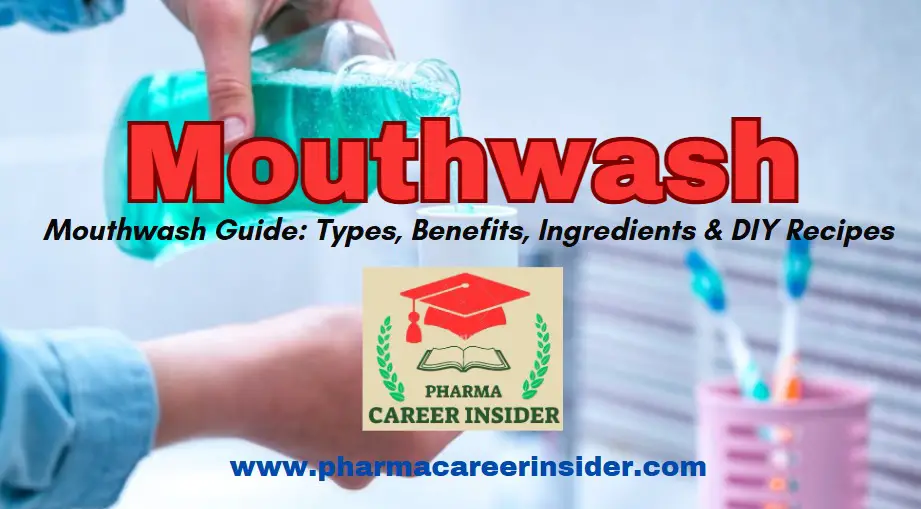Meta Description
Learn about mouthwashes—types, benefits, ingredients & DIY recipes. Improve oral hygiene & freshen breath with the best mouthwash solutions!
Introduction
Mouthwash is an essential oral hygiene product used to freshen breath, kill bacteria, and prevent dental diseases. Available in various types, including antiseptic, fluoride, and herbal mouthwashes, it complements brushing and flossing for a healthier mouth. Mouthwashes help reduce plaque, gingivitis, and bad breath while soothing oral irritations.
In this guide, explore the definition, types, key ingredients, benefits, and DIY mouthwash recipes for both commercial and homemade use. Whether you need an alcohol-free mouthwash, a fluoride rinse for cavity prevention, or a natural solution, find the best option for your oral care routine.
Definition of Mouthwash
A mouthwash (an oral rinse) is a liquid solution used to rinse the mouth, teeth, and gums to eliminate bacteria, freshen breath, and provide therapeutic effects. Depending on their purpose, mouthwashes can be antiseptic, fluoride-based, or herbal.
Characteristics of Mouthwashes
- Aqueous solutions: Water-based with dissolved active ingredients.
- Medicated or Non-medicated: Some contain antiseptics, fluoride, or herbal extracts.
- Adjunct to brushing: Not a replacement for brushing and flossing.
- Varied compositions: Alcohol-based or alcohol-free options available.
Types of Mouthwashes
Mouthwashes are classified based on their composition and intended use.
1. Cosmetic Mouthwashes
Used primarily for freshening breath and removing debris but do not provide long-term therapeutic benefits.
- Examples: Mint-based commercial rinses
- Uses: Temporary breath freshening, mild odor control
2. Antiseptic Mouthwashes
Contains antimicrobial agents to kill bacteria, fungi, and viruses.
- Examples: Chlorhexidine, povidone-iodine, cetylpyridinium chloride
- Uses: Treat gum infections, post-surgical oral care, plaque prevention
3. Fluoride Mouthwashes
Designed to strengthen tooth enamel and prevent cavities.
- Examples: Sodium fluoride, stannous fluoride
- Uses: Cavity prevention, remineralization of teeth
4. Herbal or Natural Mouthwashes
Made from plant-based ingredients, free from artificial chemicals.
- Examples: Tea tree oil, aloe vera, peppermint oil
- Uses: Fresh breath, minor antibacterial effects, gentle on gums
5. Alcohol-Free Mouthwashes
Suitable for individuals with alcohol sensitivity or dry mouth.
- Examples: Chlorhexidine-based or herbal solutions
- Uses: Safe for children, people with xerostomia (dry mouth)
6. Anti-plaque and Anti-Gingivitis Mouthwashes
Help reduce plaque buildup and prevent gum diseases.
- Examples: Chlorhexidine, essential oils (thymol, eucalyptol)
- Uses: Prevent gingivitis, reduce plaque formation
7. Prescription Mouthwashes
Medicated rinses are prescribed for severe oral conditions.
- Examples: Chlorhexidine gluconate, benzydamine
- Uses: Post-surgical care, severe gum diseases, oral ulcers
Ingredients in Mouthwashes
Mouthwashes contain a variety of ingredients that provide therapeutic and cosmetic benefits.
1. Active Ingredients
- Antiseptics: Chlorhexidine, povidone-iodine, cetylpyridinium chloride
- Fluoride Compounds: Sodium fluoride, stannous fluoride
- Astringents: Zinc chloride, alum
- Anti-inflammatory Agents: Benzydamine, herbal extracts
- Whitening Agents: Hydrogen peroxide
2. Solvents
- Water: Primary base
- Alcohol (in some mouthwashes): Acts as a solvent and preservative
3. Flavoring and Soothing Agents
- Essential oils (peppermint, eucalyptus, tea tree oil)
- Sweeteners (sorbitol, xylitol)
4. pH Buffers
- Sodium bicarbonate
- Phosphates
5. Preservatives
- Sodium benzoate
- Parabens
Benefits of Using Mouthwash
Mouthwashes provide numerous benefits when used as part of a daily oral hygiene routine.
- Freshens breath: Eliminates bad breath by killing odor-causing bacteria.
- Kills bacteria and viruses: Reduces microbial load in the mouth.
- Prevents gum diseases: Helps in the prevention of gingivitis and periodontitis.
- Strengthens enamel: Fluoride-based rinses prevent tooth decay.
- Reduces plaque buildup: Certain mouthwashes prevent tartar accumulation.
- Soothes oral irritations: Herbal mouthwashes provide a calming effect on gums.
- Post-surgical healing: Prescription mouthwashes aid in recovery after oral surgery.
Preparation of Mouthwashes
Mouthwashes can be commercially manufactured or prepared at home using natural ingredients.
Pharmaceutical Preparation of Mouthwashes
Commercial mouthwashes follow standardized formulations to ensure efficacy and safety.
Standard Formulation Process:
- Dissolve Active Ingredients: Mix antiseptics, fluoride, or herbal extracts in purified water.
- Add Solvents and Preservatives: Incorporate alcohol (if required) and stabilizers.
- Adjust pH: Use buffers to maintain a suitable pH.
- Filter and Package: Sterilize the solution and store it in sealed bottles.
Homemade Mouthwash Recipes
Homemade mouthwashes offer a natural alternative free from artificial chemicals.
1. Saltwater Mouthwash
- Ingredients: 1 teaspoon salt, and 1 glass warm water.
- Preparation: Dissolve salt in warm water, swish the solution around your mouth for 30 seconds, and then spit it out.
- Uses: Helps in minor gum inflammation and sore throat.
2. Baking Soda Mouthwash
- Ingredients: 1 teaspoon baking soda and 1 glass warm water
- Preparation: Dissolve baking soda in warm water, rinse your mouth with the solution, and use it twice daily.
- Uses: Neutralizes acid and freshens breath.
3. Herbal Mouthwash
- Ingredients: 1 cup water, 1 teaspoon peppermint oil, and 1 teaspoon tea tree oil
- Preparation: Thoroughly mix all ingredients and use as needed.
- Uses: Provides antibacterial effects and fresh breath.
Conclusion
Mouthwashes play a crucial role in maintaining oral hygiene by reducing bacteria, freshening breath, and preventing dental issues. With various types available, including antiseptic, fluoride, herbal, and prescription mouthwashes, individuals can choose the most suitable option for their needs. Whether using commercially prepared or homemade mouthwashes, incorporating them into a daily routine enhances oral health.
Frequently Asked Questions (FAQs)
1. Is mouthwash a substitute for brushing?
Answer: No, mouthwash is an adjunct to brushing and flossing, not a replacement.
2. Can children use mouthwash?
Answer: Yes, but children under 6 years should use alcohol-free and fluoride-free mouthwashes under supervision.
3. How often should I use mouthwash?
Answer: Most mouthwashes can be used twice daily after brushing.
4. Can mouthwash help with bad breath?
Answer: Yes, antiseptic and herbal mouthwashes kill odor-causing bacteria, providing fresh breath.
5. Are there any side effects of mouthwash?
Answer: Some mouthwashes may cause dry mouth, staining, or irritation if used excessively.




